Prehnite
Prehnite is an inosilicate of calcium and aluminium with the formula: Ca2Al(AlSi3O10)(OH)2. Limited Fe3+ substitutes for aluminium in the structure. Prehnite crystallizes in the orthorhombic crystal system, and most often forms as stalactitic or botryoidal aggregates, with only just the crests of small crystals showing any faces, which are almost always curved or composite. Very rarely will it form distinct, well-individualized crystals showing a square-like cross-section, including those found at the Jeffrey Mine in Asbestos, Quebec, Canada. Prehnite is brittle with an uneven fracture and a vitreous to pearly luster. Its hardness is 6-6.5, its specific gravity is 2.80-2.90 and its color varies from light green to yellow, but also colorless, blue, pink or white. In April 2000, rare orange prehnite was discovered in the Kalahari Manganese Fields, South Africa. Prehnite is mostly translucent, and rarely transparent.
| Prehnite | |
|---|---|
 | |
| General | |
| Category | Silicate mineral |
| Formula (repeating unit) | Ca2Al(AlSi3O10)(OH)2 |
| Strunz classification | 9.DP.20 (Inosilicate transitional to phyllosilicate) |
| Dana classification | 72.1.3.1 (Phyllosilicate) |
| Crystal system | Orthorhombic |
| Crystal class | Pyramidal (mm2) (same H-M symbol) |
| Space group | P2cm |
| Identification | |
| Color | Colorless to gray to yellow, yellow-green or white |
| Crystal habit | Globular, reniform to stalactitic |
| Twinning | Fine lamellar |
| Cleavage | Distinct on [001] |
| Tenacity | Brittle |
| Mohs scale hardness | 6 - 6.5 |
| Luster | Vitreous - pearly |
| Streak | White |
| Diaphaneity | Semi-transparent to translucent |
| Specific gravity | 2.8 - 2.95 |
| Optical properties | Biaxial (+) |
| Refractive index | nα = 1.611 - 1.632 nβ = 1.615 - 1.642 nγ = 1.632 - 1.665 |
| Birefringence | δ = 0.021 - 0.033 |
| Dispersion | weak r > v |
| Ultraviolet fluorescence | Fluorescent, short UV=blue white mild peach, long UV=yellow |
| References | [1][2][3][4][5] |
Though not a zeolite, prehnite is found associated with minerals such as datolite, calcite, apophyllite, stilbite, laumontite, and heulandite in veins and cavities of basaltic rocks, sometimes in granites, syenites, or gneisses. It is an indicator mineral of the prehnite-pumpellyite metamorphic facies.
It was first described in 1788 for an occurrence in the Karoo dolerites of Cradock, Eastern Cape Province, South Africa.[3] It was named for Colonel Hendrik Von Prehn (1733–1785), commander of the military forces of the Dutch colony at the Cape of Good Hope from 1768 to 1780.[3]
It is used as a gemstone.[6]
Extensive deposits of gem-quality prehnite occur in the basalt tableland surrounding Wave Hill Station in the central Northern Territory, of Australia.[7]
Gallery
 Emerald cut prehnite, 1.85 cm x 1.42 cm, 4.6 grams.
Emerald cut prehnite, 1.85 cm x 1.42 cm, 4.6 grams.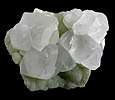 Thin plate of pea-green prehnite on which have grown calcites
Thin plate of pea-green prehnite on which have grown calcites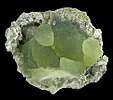 Water green color spheres of crystallized prehnite with minor calcite on basalt
Water green color spheres of crystallized prehnite with minor calcite on basalt Carved yellow prehnite pendant, 2.4 cm x 1.8 cm, 5.5 grams
Carved yellow prehnite pendant, 2.4 cm x 1.8 cm, 5.5 grams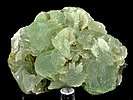 Pastel-green rosettes of prehnite blades on matrix
Pastel-green rosettes of prehnite blades on matrix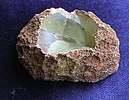 Prehnite nodule fragment, 11.0cm x 7.0cm, 338 grams.
Prehnite nodule fragment, 11.0cm x 7.0cm, 338 grams.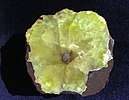 Sliced prehnite fragment with calcite core, 9.0 cm diameter.
Sliced prehnite fragment with calcite core, 9.0 cm diameter. A 2cm prehnite ball of top quality and color
A 2cm prehnite ball of top quality and color
See also
| Wikimedia Commons has media related to Prehnite. |
References
- Mineralienatlas
- http://webmineral.com/data/Prehnite.shtml Webmineral data
- http://www.mindat.org/min-3277.html Mindat
- Hurlbut, Cornelius S.; Klein, Cornelis, 1985, Manual of Mineralogy, 20th ed., ISBN 0-471-80580-7
- http://rruff.geo.arizona.edu/doclib/hom/prehnite.pdf Handbook of Mineralogy
- Tables of Gemstone Identification By Roger Dedeyne, Ivo Quintens, p. 131
- "Wave Hill". History; Discoveries. fossicking.nt.gov.au. 2016. Retrieved 2019-07-11.